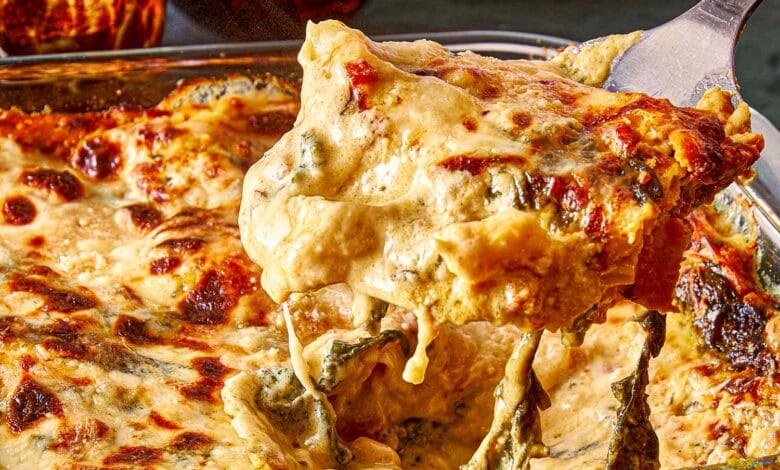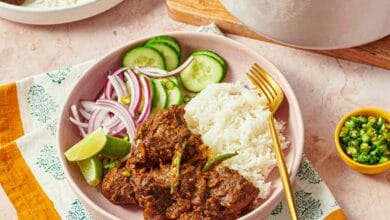A bubbly, cheese, and sage lasagna with a hint of autumn in northern Italy.

why it works
- Browning the butter and shallots before mixing them into the pumpkin puree creates a nutty, caramel-like depth that makes the filling more flavorful than just sweet.
- Thin layers of each ingredient – pumpkin, chard, béchamel, pasta – will keep your lasagna light and smooth, rather than heavy or chunky, and allow the flavors to meld without turning into mush.
Weeknight dinners feature beautiful lasagna. Layered with burnt butter, silky pumpkin, Swiss chard with salty pancetta, and bubbly Fontina Béchamel, this wine is golden, rich, and sage-scented, giving it a cheeky fall feel. It’s not fast, but all the components work reasonably well. When you take this bronze-colored, bubbling pot out of the oven, you’ll know you’ve created something special. The flavors of fall are so impressive and rich that I plan on serving it with turkey for Thanksgiving this year, and I fully expect it to compliment the turkey even more.
Although not a “classic” lasagna, lasagna di zucca e besciamela is a perfect accompaniment to northern Italy’s classic baked pasta (pasticci or pasticcio). A dish that blurs the line between pasta and casserole, with noodles, vegetables, and sauce layered luxuriously and baked. In Emilia-Romagna, Lombardy and Veneto, pumpkin (zucca) is a beloved and famous seasonal vegetable. There’s also tortelli di zucca, a delicate pasta with sweet and savory pumpkin and parmesan. Gnocchi di zucca, soft dumplings that melt in butter and sage. And now pumpkin lasagna is popping up in modern Italian kitchens.
My version is a love letter to Northern Italian cuisine and the dishes that require time and dedication. Pumpkin, sage, and burnt butter form a layer of flavor. The pancetta and chard bring another deep flavor and just enough layers of bitterness to balance out the sweetness of the pumpkin. It’s all held together by béchamel with fontina, that wonderful white sauce that the Italians claim they invented and the French claim as theirs. (To be honest, I don’t care who started it. I just appreciate that someone started it.)
pumpkin sage filling
I’ll admit that eating pumpkin puree on its own tastes like a ghost of the vegetable I once knew to be sweet. I need help. Specifically, heat, salt, and fat. That’s where the browned butter and shallots complement this filling. The butter brings a nutty richness, while the shallots and sage perfume the whole thing with an earthy, woody note that instantly feels ‘autumn’.
The beaten eggs at the end do more than just enrich the filling. It helps stabilize the mixture and bake it into a custard rather than crumbling.
Serious Eats / Lorena Masso
swiss chard and pancetta
The combination of buttery pumpkin layers and silky béchamel can be just too good to be true. Rich for rich, soft for soft. Layers of pancetta and Swiss chard add balance and contrasting textures to the lasagna. The pancetta is baked until the edges are golden brown and crispy, but the center remains slightly chewy. This textural balance ensures that the pancetta doesn’t melt into the mix, providing a satisfying contrast to the soft pasta and creamy ingredients. When cooked, the rendered fat becomes the basis for the flavoring of the garlic, thyme, and red pepper flakes that infuse the vegetables. Red pepper flakes are optional, but recommended. I think the subtle spiciness is what makes this dish interesting.
Once fragrant, add the chard, cover the pot and steam until wilted and soft. Then open the lid and continue cooking until most of the liquid has evaporated. You want your vegetables to be supple and concentrated, not soggy. The mild, earthy bitterness of the chard and the saltiness and flavor of the pancetta cut through the sweetness of the pumpkin and the richness of the béchamel, making each bite balanced, layered, and far from “baby food” territory.
Bechamel (or bechamela, depending on who you ask)
Some people claim to hate white sauce, but I’ll never understand that. Béchamel is a culinary feat that turns a handful of humble ingredients (butter, flour, milk) into silk. The French call this one of the mother sauces. Italians also claim bechamela as their own, mixing it into almost every lasagna north of Rome. I’m not here to mediate that particular custody battle, but I will say this. In the right person, Béchamel is anything but bland. Here, it’s a creamy bridge between sweet pumpkin, bitter vegetables, and soft pasta sheets.
Classic béchamel is all about proportions. Too much flour and you’re eating paste. Too little and it will be like pouring milk. For lasagna, a thin béchamel (about 1 tablespoon of flour to 1 cup of milk) is ideal because it thickens even more when baked. My version includes shredded fontina, a rich alpine cheese that has a buttery, slightly nutty flavor and melts beautifully. Adding a pinch of nutmeg brings everything together and brings out the sweetness of the pumpkin.
If you’ve ever whipped up a roux in a panic because you were worried about clumps, don’t worry. Béchamel is more forgiving than its reputation suggests. Melt the butter, add the flour and mix, then slowly add the milk. A little vigorous whisking is enough to make a smooth sauce.
Serious Eats / Lorena Masso
How to choose and handle pasta
As Daniel covers in his Lasagna Bolognese recipe, you don’t have to be a martyr when it comes to noodles to make great lasagna. Indeed, homemade fresh lasagna rolled from egg-rich dough is the pinnacle, smooth, supple and definitely special. But those aren’t the prerequisites for a truly great lasagna. Supermarkets are also increasingly carrying firm fresh (and frozen) lasagna sheets that yield delicious results with far less effort. Also, dry pasta, including uncooked dried noodles, definitely works here.
Lasagna noodles are not al dente like spaghetti. It should be relaxed beyond al dente in the baked dish so that the fork glides with minimal resistance. That’s why, in this situation, decent dried pasta is no different from fresh pasta. It can withstand “beyond al dente” treatment.
If you’re interested in making dough, Niki Achitov-Gray’s fresh pasta recipes are a great place to start. One of the benefits of DIY sheets is that you can control the thickness. Aim for setting 6 or 7 on your pasta machine. This is thin enough to keep the layer delicate, but not so thin that it veers into translucent areas and gets buried in the assembled dish. Cut the rolled sheet into manageable rectangles about 8 inches long. Here are some cooking tips for each type of pasta.
Keep homemade fresh pasta partially cooked: Boil them in salted water until they are just slightly chewy (they will become even softer in the oven). Immediately cool in an ice bath, drain completely and rub each sheet lightly with oil to prevent sticking. To assemble in stages, layer the greased sheets on a parchment paper-lined tray and place plastic wrap between the layers. It will hold for several hours without coalescing into a tragic pasta brick.
Use commercially available fresh or frozen sheets: Treat it like it’s homemade. Boil immediately, put in an ice bath, drain, and keep the oil thin. A shortcut to silky, supple layers.
If using dried pasta: Boil until al dente, cool on ice, drain water, drain oil, and store as above. Dried pasta is perfect for baking because it gives us the soft, sliceable texture we’re looking for.
Use noodles without boiling them (yes, noodles are welcome here): For the most reliable results, start early. Pre-hydrate by soaking in warm water for about 30 minutes, then pat dry to assemble. This prevents the center from becoming whitish and allows the sheets to blend with the filling instead of drawing moisture from the béchamel.
Whether it’s hand-rolled, store-bought raw, classic dried, or unboiled, the goal is to create thin, pliable sheets that pair well with pumpkin, chard, and fontina béchamel.
parliament
When assembling lasagna, the goal is to build delicate, balanced layers between each layer. Too much pumpkin will turn into baby food. Too much béchamel will result in a dairy-based soup. Each layer should be thin enough that the shadow of the pasta can be seen through. Layer pumpkin, chard, béchamel, and cheese in that order. Repeat this. Finally, sprinkle with more béchamel, drizzled Parmesan, and fontina.
Bake until the top is bronzed and bubbly, then let it rest for at least 20 minutes (this is the hardest part). It takes a while to set, so you can cut a nice slice instead of scooping up a delicious but watery mess. This lasagna may be a labor of love, but it’s one that will pay off with golden, bubbly dividends.
2025-10-21 18:38:00




